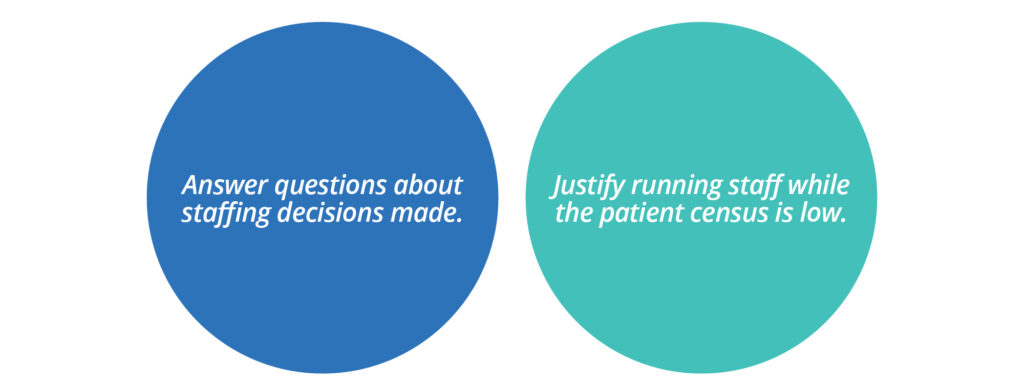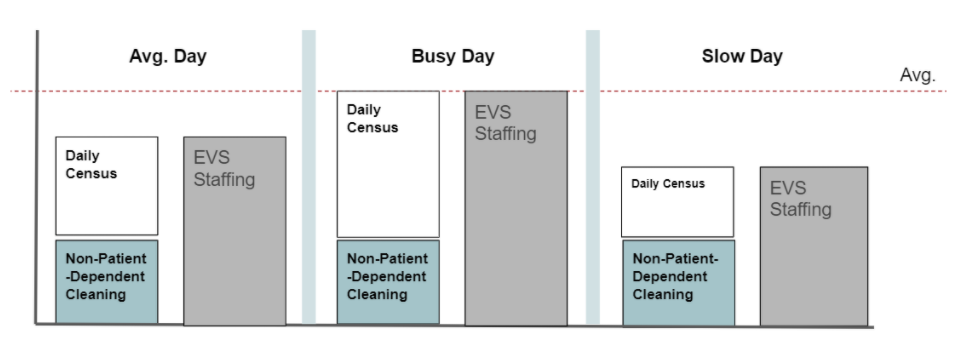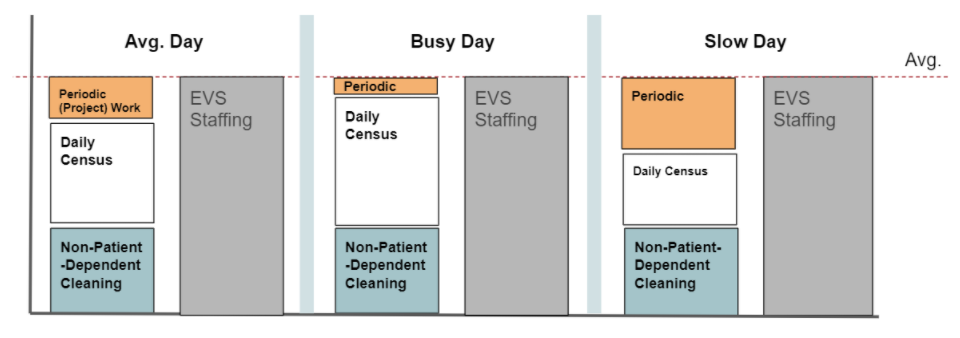insights
Talking Productivity in Environmental Services Departments
Three Charts to Shape the EVS Productivity Conversation
Productivity is a daily topic in hospitals, both for operations and for clinical staff. The goal is to make the most of your human resources on duty, getting as close to 100% productivity as possible. We’re betting that if you’re an Environmental Services Director you are having regular conversations with administrative leaders about your department’s staffing levels and productivity.
The topic is challenging. Standard thinking about how to calculate productivity tends to neglect key realities of EVS operations. Productivity is considered mostly a function of patient volume. While this may be better suited to clinical functions, where the work is patient-centric, it overlooks key factors of operational functions. In the case of Environmental Services: the amount of cleanable space in a hospital that needs to be cleaned, sterilized, and kept safe doesn’t change based on the number of patients in beds. While patients may come and go, the facility does not.
The lobby needs to shine whether there are five customers crossing through it or 500. Cleaning frequencies for common areas of the hospital such as laundry, nurses stations, corridors, and public restrooms do not fluctuate proportionately to patient volumes. Sometimes family members sitting with a patient will go into empty patient rooms to sleep, or nurses will enter to wash their hands—so, often, even “empty” rooms require policing and cleaning.
While productivity is on everyone’s mind, department heads aren’t expected to calculate it. But they do need to manage for it. Here is what an EVS director must do in terms of productivity:
- Answer questions about staffing decisions made.
- Justify running staff while the patient census is low.
Below are some tools to help you have these conversations when your staffing levels don’t meet administration’s expectations. Also, they will help you illustrate how productivity should be looked at for the Environmental Services Department.
1) Census-Centric View of Productivity:
How EVS Productivity is Commonly Viewed
Problem: This point of view overlooks important realities of Environmental Services management, namely Non-Patient-Dependent Cleaning. These are requirements that do not fluctuate with the daily census. Examples include fixed areas such as:
- Emergency
- OR
- Radiology
- Labor & Delivery
- Lock-in Positions
- Trash & Linen Disruption
These are fixed components that need to be staffed regardless of inpatient volumes.
Solution: See the next chart.
2) Better: Takes into Account Non-Patient-Dependent Cleaning
This chart illustrates why the expected EVS staffing levels shouldn’t fluctuate in direct proportion to patient census.
Problem: While this is better, it leaves a managerial problem for EVS leadership — fluctuating work schedules are hard on employee morale and lead to turnover. EVS Techs have mortgages to maintain and families to support. They need consistent, reliable work schedules to do this. If the hospital can’t provide it, employees are obliged to seek more stable employment.
Solution: See the next chart.
3) Best: Maintain productivity, while ensuring consistent employee hours by flexing project work schedules.
If you are an EVS Director, you are likely already flexing project work schedules to make the best use of your staff.
This chart paints the picture of how EVS staffing levels can seldom fluctuate on a day-to-day basis, but productivity doesn’t suffer. When there is a slow day (daily bed count combined with non-patient-dependent cleaning is lower than average), your EVS department will have minutes to spare. Rather than send employees home, you are moving periodic work, which is less time sensitive, to these days for completion.
It creates a more consistent staffing model without losing productivity.
Tools to Manage for EVS Productivity
If you are a Smart Facility Software user, you have productivity management tools to both calculate staffing levels needed and easily move project work based on the daily census.
- The Census Based Scheduling module in ES Optimizer allows a daily import of the census. It has tools for easily scheduling the census work and adding assignments in for the remaining minutes.
- With Service Optimizer, you can monitor completed tasks in real-time, allowing you to make data-backed decisions about where to send employees and optimize productivity.
- The mobile communications features in Service Optimizer make reassigning and redirecting employee resources even more efficient. They enable back-and-forth communication between managers and employees about shifting priorities while they’re on the floor.
Reach out to us for more information on these features.






